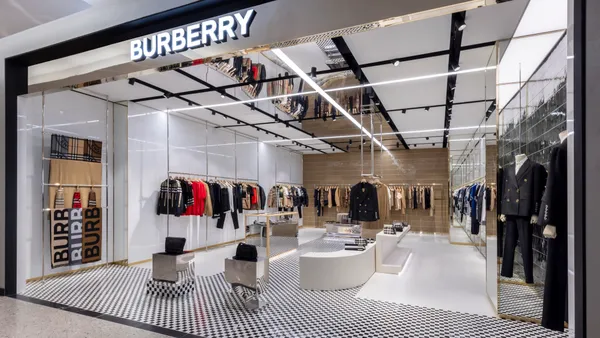While the likes of Macy’s, Urban Outfitters and other retailers in recent earnings discussions called out uncooperative weather and/or macroeconomic headwinds as challenges, Abercrombie & Fitch Co. executives discussed neither.
In a recent report, Morgan Stanley analysts led by Alex Straton noted that lack of discussion around weather or other headwinds. "This lends credibility to the idea that there have been legitimate changes to the A&F banner such as a more disciplined inventory management, increased ‘core’ assortment, and greater exposure to more stable, higher [income] consumers, among others ...that altogether minimize the business’ margin volatility” compared to its own history and its rivals, they said.
It further suggests that Abercrombie’s improvements “are durable,” they also said. This is a remarkable shift for a brand that was in shambles a decade ago, when Mike Jeffries finally stepped down as CEO. Today, in an era when AI seems poised to only amplify the role of technology in running an apparel brand, observers credit much of Abercrombie & Fitch’s rehabilitation to something they say many apparel retailers have long neglected: old fashioned merchandising chops.
Jeffries has been widely blamed for the apparel retailer’s past troubles — a history of discrimination and sexualized marketing that helped land it on the American Customer Satisfaction Index of least liked brands in the U.S. Despite all that, the company struggled to replace him for years, clouding hope for meaningful progress as sales continually faltered.
Now, though, Abercrombie & Fitch Co., which runs the namesake brand and its sister, teen line Hollister, is a standout in an otherwise tepid apparel segment. In 2023 net sales rose 16% year over year, reaching $4.3 billion, as comps rose 13% and gross margin expanded by 600 basis points to 62.9%. The momentum continued in Q1, when the company topped a record-setting billion dollars in net sales, and comps rose 21%. Net sales at the Abercrombie brand in the period grew 31.1% to $571.5 million, with comps up 29%, and at Hollister grew 12.3% to $449.2 million, with comps up 13%.
“Ten or so years ago, many had written off Abercrombie & Fitch. Today, the company is producing extraordinary results which mark it out as one of the best performers in the retail market,” GlobalData Managing Director Neil Saunders said in emailed comments. “This is the result of years of hard work to reengineer the brand, so it connects with the needs and desires of modern consumers. Enacting a 180-degree turn is extremely difficult at the best of times, but to deliver this against the backdrop of first a pandemic and then a period of economic disruption is a testament to the focus and skill of management and all working in the business.”
Merchant led
“Management” at Abercrombie & Fitch Co. is led by Fran Horowitz, who had nearly 30 years of merchandising experience before she joined the company in 2014 to lead its Hollister brand. A year later she was promoted to chief merchant for the entire company, and shortly after was part of an interim team of three executives that took over from Jeffries when he left.
“At Abercrombie & Fitch, Fran has always been about making the product the hero. When you talk to her, she’s enthusiastic about the small things and the details,” Saunders said. “That bleeds into the team and sets the right culture. This has played a big role in the brand’s revival, especially since product design had to really evolve and change as part of the brand’s restoration.”
She was officially tapped as sole CEO of the parent company in 2017. Corey Robinson, who has been with the company in various merchandising roles for nearly 20 years, is currently chief product officer and oversees multiple functions in both merchandising and design.
Unsurprisingly, the company uses data to help it make informed decisions around its assortment, according to a company spokesperson. But the team also believes “there is an art and science behind merchandising,” the spokesperson said by email.
"The art of buying cannot be replicated by AI because this industry is based on creativity and understanding what the consumer wants/needs.”

Rimi Gill
Retail Strategy Consultant, Retail Evolved
An overly automated system “cannot replace the human touch — The human intuition on trends, recognizing the sentiment of the customer you're buying for, or knowing how to plan sales for the following year based on your buys,” said Rimi Gill, a retail strategy consultant with Retail Evolved, who has worked with the company.
“Automization is a buzz word in the retail industry now. Many chief merchandising officers and CEOs believe systems and automization will help drive their retail business and cut costs. But in turn what they are seeing is loss of customers and sales declining because they are losing sight of the human advantage,” she said. “There is definitely a place for automization in merchandising, for menial tasks, but the art of buying cannot be replicated by AI because this industry is based on creativity and understanding what the consumer wants/needs.”
Other observers have noted that Gap, a brand that once defined casual American style, fell into this trap. By contrast, a strong merchandising team who understands the strengths and limits of data helps a retailer advance, Gill said by email.
“As a buyer who worked closely with Abercrombie & Fitch I know the company is a merchant-led retailer. Because of their human advantage they have stayed relevant from the ‘90s to present (with a few blips in between) as they have been able to recognize and evolve with their teen customer base,” she said. “Walking at their offices in Columbus, Ohio, you can see that the brand even hires merchants who happen to be their customers that live and breathe the Abercrombie & Fitch lifestyle. The merchandising division is at the forefront of decisions being made in their company.”
The merchant mind
Both Abercrombie & Fitch and Hollister have become nimble apparel sellers because they understand their customers, according to experts — and Horowitz herself.
“We’ve further defined what each of our brands stands for and the customers they serve, presenting a significant global addressable market opportunity they are capitalizing on with relevant assortments and compelling brand voice,” Horowitz told analysts during the company’s most recent earnings call. “Both brand families are contributing nicely to our business results while expanding our customer base through increased marketing spend and improved omnichannel customer experience.”
The merchandising team developed Abercrombie’s new Wedding Shop from customer insights from both men and women interested in various types of apparel suitable for matrimonial events of various kinds. Based on the success of the Wedding Shop, Horowitz said the merchandising team may explore more such brand extensions.
“The Wedding Shop has brought in lots of new customers. It’s also been an opportunity to add value to the customers that we already have,” she said. “It was built off an extension of this best-dressed guest collection that we had already seen success in, so we are seeing exciting acquisition by customer.”
Horowitz’s merchandising background is evident when she speaks, according to Liza Amlani, principal and co-founder of Retail Strategy Group.
“When I look at commentary around ‘being more customer focused,’ ‘listening to the customer’ — these are all things that are part of the merchant world and the way a merchant thinks,” Amlani said by phone. “’What does my customer want? Am I listening to her? Am I listening to him and closing the feedback loop?’ And that's exactly what Fran does.”
The brand’s success with dresses epitomizes this, Amlani said. It’s now a top category for Abercrombie & Fitch, thanks to a mindset that listens to the customer and invests in that demand.
“Having that merchant mind is the way a merchant thinks about the customer and connecting them to product,” she said. “That is why Abercrombie I think has really come up from the trenches of their past.”
It also means that the product has attributes that stand out, according to Saunders.
“Attention to detail in fashion is important, even within the mass market. The small things Abercrombie and Fitch has changed like better buttons, softer fabrics, and little design embellishments all make its proposition more defensible in a crowded and competitive marketplace,” he said. “They also represent added value which gives people a reason to spend a bit more on the products rather than trade down to cheaper alternatives – of which there are many.”
Merchandising improvements extend to stores, as well, which no longer have the dark, heavily perfumed ambiance favored by Jeffries, as well as more inclusive messaging, according to Amlani.
“The customer experience has completely shifted from what Abercrombie was under Michael Jeffries to what it is today,” she said. “We've seen a transformation where you're not going into this dark store with these white models. The lighting alone has allowed more customers to come in, it just gives a different feeling. It's not this dark, sexy, exclusive place to shop —it’s for a lot more customers.”
Correction: This story has been updated to reflect that Corey Robinson has been with Abercrombie & Fitch Co. for nearly 20 years.























